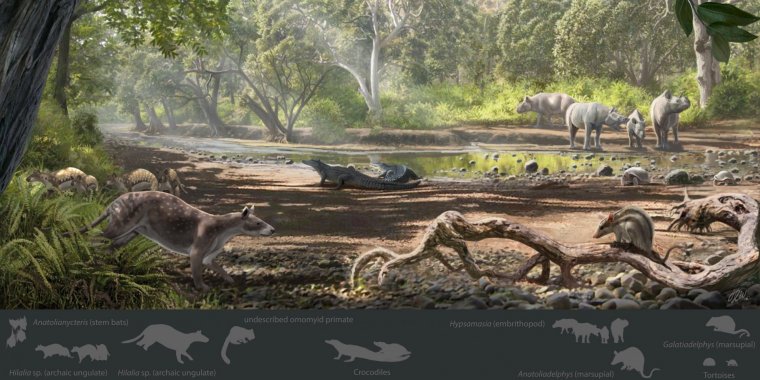| News / Science News |
Fossil discovery adds to understanding of how geological changes affected evolution of mammalian life
The discovery of fossil teeth from two marsupial species that lived 43 million years ago on what was at that time an island provides key insights into the influence of geological changes on the evolution of mammals.

Reconstruction of the Eocene paleoenvironment of the Pontide terrane in Turkey, where the new marsupial fossils were found. Credit: Oscar Sanisidro/University of Kansas
The dominant model for understanding animal movement is that the most important factors are an island's size and its distance from the colonizing animals' territory. However, the discovery of the fossils -- from Galatiadelphys minor and Orhaniyeia nauta -- indicate that an island's geological context is more important to influencing changes in animal movement and evolution.
The fossil discovery occurred in the Pontide terrane, an area in present-day Turkey that was once an island located between contemporary Asia and Africa.
While a poor fossil record is a challenge that researchers commonly face, the site in Turkey is particularly fruitful for the research.
"Here, we're able to study in great detail how this ancient island evolved -- where organisms came from, how they got there and when they got there," K. Christopher Beard, a paleontologist at the University of Kansas (KU) said. "No other ecosystem on the face of the planet from any time period perfectly matches what we're finding. It's a completely unique mammalian ecosystem, much as Madagascar is today."
Beard said that the two newly described fossil marsupials lived atop the food chain because other carnivores were unable to reach the small island.
But the marsupials' dominant status changed, according to the researchers, when tectonic plate movement joined the ancient island with the larger landmass. That joining enabled potential predators and competitors to access the environment.
Neither of the newly discovered species has living descendants.
The incredibly interesting and unique biota that occurred on this island was totally eradicated at some point as the island reconnected to mainland Eurasia and more cosmopolitan animals were able to access it.
The team's findings overturn a prevailing model of evolution, which holds that the key criteria for animals' access to an island are its size and its distance from the colonizing animals' source territory. The geological context is likely of greater importance. (National Science Foundation)
YOU MAY ALSO LIKE



